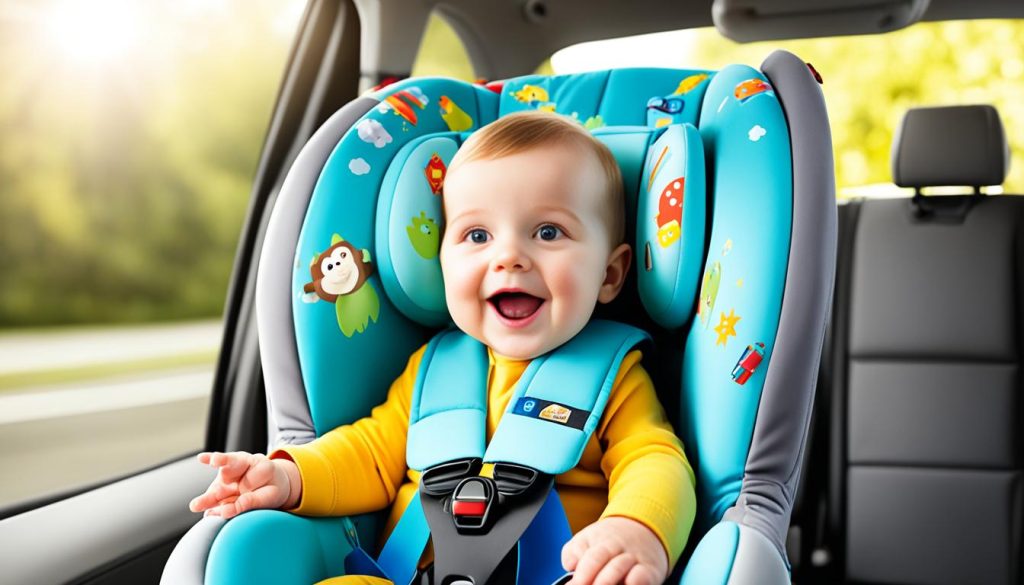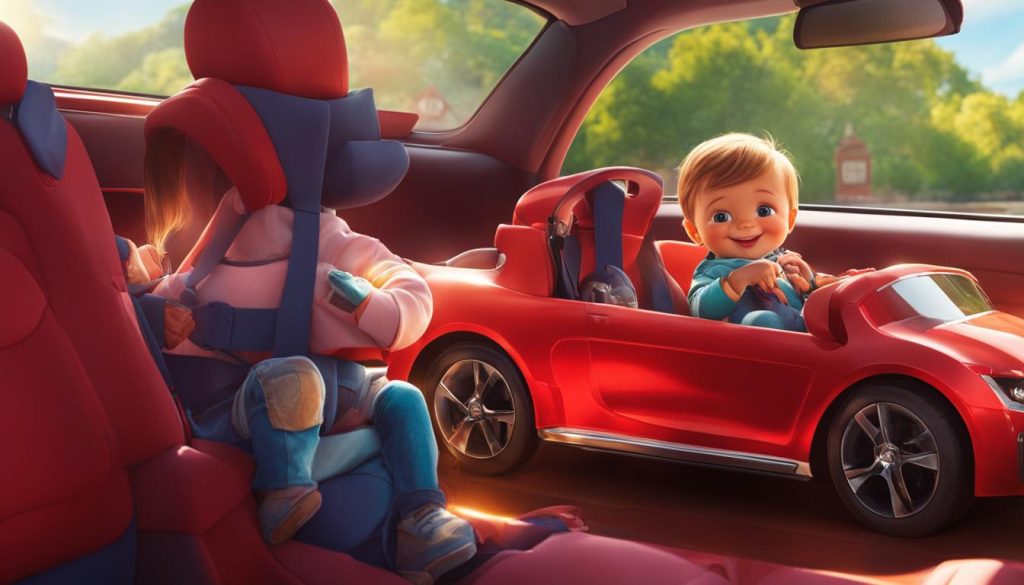In Alberta, ensuring the safety of our children is a top priority. That’s why it is essential to familiarize ourselves with the car seat rules and regulations that keep our little ones safe on the road. By following these guidelines, we can provide the best protection for our children and peace of mind for ourselves.
Research has shown that child safety seats can significantly reduce the risk of serious and fatal injuries by 60 to 70%. Understanding and abiding by the car seat rules in Alberta is crucial to ensuring your child’s safety and compliance every time you hit the road.
Key Takeaways:
- Alberta has specific guidelines for rear-facing car seats, forward-facing car seats, booster seats, and seat belts.
- Children should remain in a rear-facing car seat until they are at least 2 years old or have reached the maximum weight or height limit set by the manufacturer.
- Forward-facing car seats with a harness should be used until children are at least 6 years old or have reached the maximum height or weight limit set by the manufacturer.
- Booster seats are highly recommended for children between the ages of 6 and 15 or those who weigh more than 40 lbs.
- Children can transition to using a seat belt when they can properly fit in one, usually when they are at least 145 cm (4’9″) tall and between 8 and 12 years old.
Rear-Facing Car Seats: Birth Until at Least 2 Years
When it comes to the safety of infants and young children in vehicles, rear-facing car seats offer the highest level of protection. In Alberta, it is recommended that children remain in a rear-facing car seat until they are at least 2 years old. However, the decision to transition to a forward-facing seat can also be based on reaching the maximum weight or height limit provided by the car seat manufacturer.
Rear-facing car seats are designed to support and protect a child’s head, neck, and spine during sudden stops or crashes. This positioning helps distribute the force of impact over a larger area, reducing the risk of serious injuries. Research has shown that using a rear-facing car seat can significantly decrease the likelihood of severe injuries or even fatalities.
It’s important to check the weight and height limits specified by the manufacturer for your specific rear-facing car seat. Once a child has outgrown these limits, it is time to consider transitioning to a forward-facing car seat with a harness system.
Remember, the longer a child can remain in a rear-facing car seat, the better their protection and safety in the event of a collision. It’s crucial to follow the guidelines set by the car seat manufacturer and adhere to the laws and regulations of Alberta to ensure your child’s safety on the road.

| Rear-Facing Car Seats | Birth Until at Least 2 Years |
|---|---|
| Recommended Age | Birth until at least 2 years |
| Weight Limit | Determined by the car seat manufacturer |
| Height Limit | Determined by the car seat manufacturer |
| Benefits |
|
| Transition | Move to a forward-facing car seat once the child has outgrown the weight or height limits specified by the manufacturer |
Forward-Facing Car Seats: At Least 2 Years Until at Least 6 Years or 40 lbs
Once a child has outgrown their rear-facing car seat, it is time to transition to a forward-facing car seat. Forward-facing car seats provide additional protection as children continue to grow. In Alberta, it is recommended that children use a forward-facing car seat until they are at least 6 years old or have reached the maximum height or weight limit set by the manufacturer.
The forward-facing car seat comes with a five-point harness, ensuring that your child stays securely in place during travel. The harness should be adjusted to fit snugly across the shoulders and hips, keeping your child safe and comfortable throughout the journey.
When installing a forward-facing car seat, make sure to follow the manufacturer’s instructions and use the seat belt or LATCH system correctly for a proper and secure fit. It is essential to check the car seat’s height and weight limits regularly and transition to the next type of car seat when necessary.

Benefits of Forward-Facing Car Seats
- Enhanced protection: Forward-facing car seats provide additional protection for children as they face the front of the vehicle.
- Five-point harness: The five-point harness keeps the child securely in place and reduces the risk of injury during sudden stops or collisions.
- Comfortable travel: The design of forward-facing car seats ensures that children can sit comfortably and enjoy the ride.
- Longer usability: Forward-facing car seats have higher weight and height limits, allowing children to use them for an extended period.
| Age | Height | Weight |
|---|---|---|
| At least 2 years old | Varies by manufacturer | Varies by manufacturer |
| Up to 6 years old | Varies by manufacturer | Varies by manufacturer |
Booster Seats: At Least 6 Years or 40 lbs Until a Seat Belt Fits
While not legally required in Alberta, booster seats are highly recommended for children between the ages of 6 and 15 or those who weigh more than 40 lbs. Booster seats help position the child so that the seat belt fits properly across their chest and hips, reducing the risk of injury. Children should remain in a booster seat until they reach the maximum height or weight limit set by the manufacturer and a seat belt fits them properly.
Boosters seats provide a necessary transition for children who have outgrown their forward-facing car seats but are not yet tall enough or weigh enough to fit in a seat belt properly. They provide an extra boost in height and ensure that the seat belt is positioned correctly, distributing the force of a crash over the strongest parts of their bodies.
When using a booster seat, it’s crucial to follow the manufacturer’s guidelines regarding the height and weight limits. Booster seats are typically equipped with a weight limit, which indicates the maximum weight a child can have while using the booster seat.
Additionally, it’s important to check the seat belt fit when using a booster seat. A properly fitting seat belt should rest comfortably across the child’s shoulder and chest, without cutting into their neck or sliding off their shoulder. The lap belt should sit low on their hips, touching the upper thighs, and not covering their stomach. If the seat belt does not fit correctly, a booster seat is necessary to ensure the child’s safety during a car ride.
Booster seats come in various designs, including high-back boosters and backless boosters. High-back boosters provide additional head and neck support and are suitable for vehicles without headrests or low-back seats. Backless boosters are more portable and can be used in vehicles with headrests. Both types of boosters provide the necessary height and positioning to ensure proper seat belt fit.
| Age Range | Weight Range | Booster Seat Type |
|---|---|---|
| 6-8 years | 40-80 lbs | High-back or backless booster seat |
| 8-12 years | 80-120 lbs | Backless booster seat |
| 12+ years | 120+ lbs | No booster seat required, can use seat belt directly |
Remember, the ultimate goal is to ensure that the seat belt fits properly and securely across your child’s body. Don’t rush the transition from a booster seat to a seat belt. It’s important to wait until your child meets the height and weight requirements before making this move to ensure their safety on every journey.
Seat Belts: When a Child Can Properly Fit
Once a child can properly fit in a seat belt, they can transition out of a booster seat. Typically, this occurs when they reach a height of at least 145 cm (4’9″) and are between 8 and 12 years old. At this stage, it is crucial to ensure that the seat belt fits them correctly for optimal safety.
The seat belt should fit comfortably across the child’s body. Their knees should be bent at the seat’s edge, allowing them to sit with their back against the seat, while the shoulder belt should cross their chest between the neck and shoulder. The lap belt should securely cross their hips; it should not ride up across their stomach. A properly fitted seat belt ensures that the child is protected in the event of sudden stops or collisions.
While transitioning to a seat belt, it is advisable for children to continue sitting in the backseat. Backseat safety remains an essential aspect of ensuring their well-being during car journeys. It is recommended for children to remain in the backseat until they are at least 13 years old, as this offers an added layer of protection.